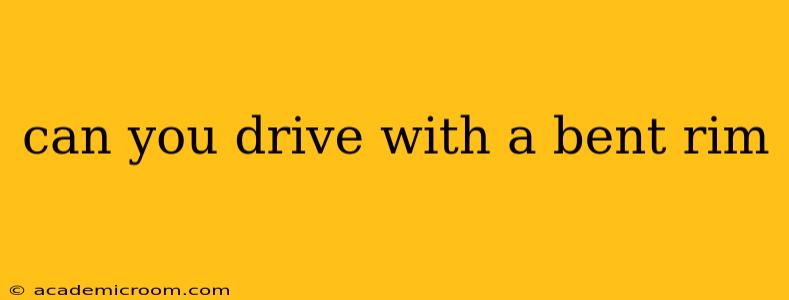Can You Drive With a Bent Rim? The Risks and Realities
Driving with a bent rim is a risky proposition, and the answer is a resounding maybe, but it's strongly advised against. While you might be able to drive a short distance on a slightly bent rim, doing so carries significant dangers that outweigh any perceived convenience. This article explores the risks, when it might be acceptable (with caveats), and the best course of action.
How Much Damage is Too Much?
The severity of the bend determines the level of risk. A minor bend might only cause a slight vibration, while a severe bend can lead to tire failure, damage to other components, and even a loss of control. Here's a breakdown:
- Minor Bend (Slight Wobble): A very small bend might only cause a noticeable vibration, particularly at higher speeds. This is the least dangerous scenario, but still poses risks.
- Moderate Bend (Significant Wobble): A more pronounced bend will result in a stronger vibration and potential handling issues. This makes driving difficult and unsafe.
- Severe Bend (Visible Damage): A severely bent rim is likely to cause significant vibration, uneven tire wear, and a high risk of tire blowout. Driving in this condition is extremely dangerous and should be avoided completely.
What Happens When You Drive on a Bent Rim?
Driving with a bent rim can lead to a number of problems:
- Uneven Tire Wear: The bent rim causes the tire to contact the road unevenly, resulting in rapid and uneven wear. This necessitates premature tire replacement, costing you more money in the long run.
- Vibration and Handling Issues: The imbalance created by the bent rim causes vibration throughout the vehicle, affecting handling and potentially making it difficult to maintain control, especially at higher speeds.
- Tire Blowout: A severely bent rim can weaken the tire's structure, increasing the risk of a blowout. A blowout can lead to loss of control and a serious accident.
- Wheel Bearing Damage: The added stress on the wheel bearings from a bent rim can cause premature wear and eventual failure, resulting in expensive repairs.
- Suspension Damage: Over time, the constant vibration and imbalance can put extra stress on the suspension components, potentially leading to damage.
Can I Drive a Short Distance on a Bent Rim?
Driving a very short distance to a nearby tire shop or mechanic might seem acceptable in a case of a minor bend, but proceed with extreme caution. Keep the speed low, avoid sharp turns, and drive as smoothly as possible. This is only a temporary measure; get it fixed immediately.
What are the repair options for a bent rim?
Repair options depend on the severity of the bend:
- Minor bends: Sometimes, a minor bend can be repaired by a tire professional. They might use specialized equipment to carefully reshape the rim.
- Moderate to severe bends: Often, a severely bent rim is beyond repair and needs replacement. The cost of repair versus replacement will determine the best course of action.
How can I prevent bent rims?
Preventing bent rims starts with careful driving:
- Avoid potholes and curbs: These are the most common culprits for bent rims.
- Maintain proper tire pressure: Under-inflated tires increase the risk of damage.
- Drive carefully on rough roads: Reduce your speed and avoid sudden movements.
In conclusion, while you might be able to drive a short distance with a minor bend, the risks far outweigh the convenience. It's always best to have a bent rim repaired or replaced as soon as possible to ensure your safety and the safety of others. Don't gamble with your safety – get it checked by a professional immediately.
